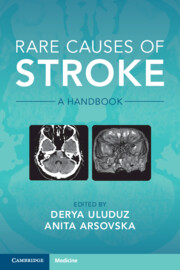Book contents
- Rare Causes of Stroke
- Rare Causes of Stroke
- Copyright page
- Contents
- Contributors
- Preface
- 1 Inflammatory Conditions
- 2 Infectious and Postinfectious Vasculitis
- 3 Hypercoagulable Causes of Stroke
- 4 Drug-Related Stroke
- 5 Hereditary and Genetic Causes of Stroke
- Chapter 5.1 Genetic Collagen Disorders
- Chapter 5.2 Genetic Small-Vessel Diseases
- Chapter 5.3 Genetic Metabolic Diseases
- 6 Rare Causes of Cardioembolism
- 7 Vasospastic Conditions and Other Vasculopathies
- 8 Other Non-inflammatory Vasculopathies
- 9 Venous Occlusive Conditions
- 10 Bone Disorders and Stroke
- Index
- References
Chapter 5.2 - Genetic Small-Vessel Diseases
from 5 - Hereditary and Genetic Causes of Stroke
Published online by Cambridge University Press: 06 October 2022
- Rare Causes of Stroke
- Rare Causes of Stroke
- Copyright page
- Contents
- Contributors
- Preface
- 1 Inflammatory Conditions
- 2 Infectious and Postinfectious Vasculitis
- 3 Hypercoagulable Causes of Stroke
- 4 Drug-Related Stroke
- 5 Hereditary and Genetic Causes of Stroke
- Chapter 5.1 Genetic Collagen Disorders
- Chapter 5.2 Genetic Small-Vessel Diseases
- Chapter 5.3 Genetic Metabolic Diseases
- 6 Rare Causes of Cardioembolism
- 7 Vasospastic Conditions and Other Vasculopathies
- 8 Other Non-inflammatory Vasculopathies
- 9 Venous Occlusive Conditions
- 10 Bone Disorders and Stroke
- Index
- References
Summary
Brain infarction due to cerebral small vessel disease (SVD) accounts for up to 25% of all ischemic strokes. CADASIL (cerebral autosomal dominant arteriopathy with subcortical infarcts and leukoencephalopathy) and CARASIL (cerebral autosomal recessive arteriopathy with subcortical infarcts and leukoencephalopathy) are among the monogenic hereditary cerebral SVDs. Herein, we reported a case of sporadic CADASIL-like disease and provided information about CADASIL and CARASIL, two of the most common of inheredited SVDs that are usually overlooked
Keywords
- Type
- Chapter
- Information
- Rare Causes of StrokeA Handbook, pp. 234 - 239Publisher: Cambridge University PressPrint publication year: 2022



